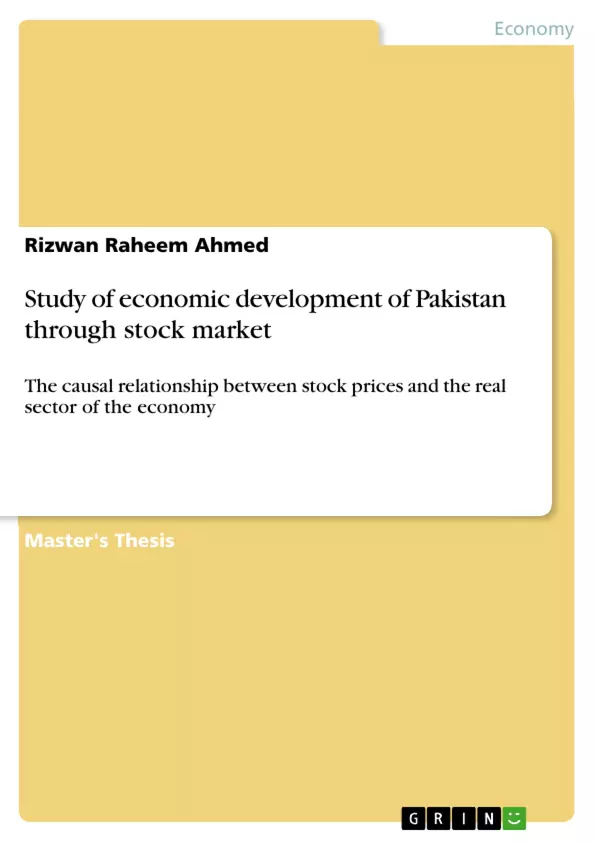
Study of economic development of Pakistan through stock market
Masterarbeit, 2007
72 Seiten
Leseprobe
Inhaltsverzeichnis (Table of Contents)
- Chapter I: INTRODUCTION
- Background of the Study
- Role of the Securities Market in Economic Development
- Stock Markets and Economic Growth
- Purpose of the Study
- Stock Markets in Pakistan
- Karachi Stock Exchange (KSE)
- KSE: Performance
- KSE Indices
- Chapter II: REVIEW OF THE LITERATURE
- Stock Market Development and Long Run Growth
- Risk Diversification - International Integration
- Financial Factors in Economic Growth: The Theoretical Nexus
- Cross-Country Econometric Evidence
- Time-Series Econometric Evidence
- Current Economic Situation of Pakistan
- Key Projections
- Summary of Pakistan's Macroeconomic Performance
- Chapter III: RESEARCH METHODOLOGY
- Data and Methodology
- Data Sources
- Descriptive Statistics
- Correlation Coefficient
- Augmented Dickey Fuller (ADF)
- Co-Integration Analysis
- Dummy Variable
- Chapter IV: DATA ANALYSIS
- Descriptive Statistics for Growth in Stock Prices and Macro Variables
- The Correlation Coefficient of Stock Prices and Macro Variable
- Efficiency of the Stock Market in Post Liberalization Period
- Causal Relations between Stock Prices and the Variables
- The Long-Run Relations of Stock Prices with Real Variables
- The Direction of Causality between Two Variables
- Shifts in Stock Prices and Real Variables
- Chapter V: SUMMARY, CONCLUSION AND RECOMMENDATIONS
- Summary & Conclusion
- Recommendations
- Suggested Areas of Further Research
Zielsetzung und Themenschwerpunkte (Objectives and Key Themes)
The study aims to investigate the causal relationship between stock prices and variables representing Pakistan's real economic sector, specifically real GDP and real investment spending. Using annual data from 1980 to 2007, the research analyzes the stochastic properties of these variables, accounting for economic liberalization in the early 1990s. The analysis explores long-term relationships and the direction of causality between stock prices and real sector variables.
- The causal relationship between stock prices and the real sector of the Pakistani economy.
- The impact of economic liberalization on the relationship between stock prices and real sector variables.
- The role of the Pakistani stock market in economic development.
- Analysis of long-run relationships and causality between stock prices and real sector indicators.
- Evaluation of the Pakistani stock market's performance and its ability to act as a leading economic indicator.
Zusammenfassung der Kapitel (Chapter Summaries)
Chapter I: INTRODUCTION: This chapter sets the stage for the study by providing background information on the role of securities markets in economic development, focusing specifically on the relationship between stock markets and economic growth. It introduces the purpose of the study, which is to examine the causal relationship between stock prices and the real sector of the Pakistani economy. The chapter also gives an overview of the Pakistani stock market, the Karachi Stock Exchange (KSE), its performance, and its key indices, providing context for the subsequent analysis.
Chapter II: REVIEW OF THE LITERATURE: This chapter reviews existing literature on the relationship between stock market development and long-run economic growth. It explores various theoretical and empirical perspectives on the financial factors that contribute to economic growth, examining both cross-country and time-series econometric evidence. The chapter also provides an overview of Pakistan's current economic situation and key macroeconomic indicators, laying the groundwork for understanding the context within which the study's empirical analysis will be conducted.
Chapter III: RESEARCH METHODOLOGY: This chapter details the research methodology employed in the study. It describes the data sources and the statistical techniques used, including descriptive statistics, correlation analysis, Augmented Dickey-Fuller (ADF) tests for stationarity, co-integration analysis to examine long-run relationships, and error correction models to investigate causality. The chapter explicitly outlines the approach taken to handle potential structural breaks in the data series due to the economic liberalization program in the early 1990s.
Chapter IV: DATA ANALYSIS: This chapter presents the results of the empirical analysis. It begins with descriptive statistics summarizing the key variables. Then, it presents the results of the correlation analysis, co-integration regressions, and error correction models, examining the relationships and direction of causality between stock prices and real sector variables. The chapter carefully analyzes the effects of the economic liberalization program on the observed relationships.
Schlüsselwörter (Keywords)
Pakistan, stock market, economic development, stock prices, real GDP, real investment, economic growth, liberalization, co-integration, causality, econometrics, Karachi Stock Exchange (KSE).
Frequently Asked Questions: Analysis of the Causal Relationship Between Stock Prices and the Real Sector in Pakistan
What is the main topic of this research?
This research investigates the causal relationship between stock prices and Pakistan's real economic sector, specifically real GDP and real investment spending. It analyzes this relationship using annual data from 1980 to 2007, considering the impact of economic liberalization in the early 1990s.
What is the scope of the study?
The study examines the stochastic properties of stock prices, real GDP, and real investment, exploring long-term relationships and the direction of causality between these variables. It also assesses the role of the Pakistani stock market in economic development and its performance as a leading economic indicator.
What data was used in this research?
The research utilizes annual data from 1980 to 2007. Specific data sources are detailed within the methodology chapter.
What methodology was employed?
The methodology includes descriptive statistics, correlation analysis, Augmented Dickey-Fuller (ADF) tests for stationarity, co-integration analysis to identify long-run relationships, and error correction models to analyze causality. The impact of economic liberalization is explicitly considered.
What are the key findings of the study (in summary)?
Detailed findings are presented in Chapter IV. The analysis explores the correlation, long-run relationships, and causal links between stock prices and macroeconomic variables. The effects of economic liberalization on these relationships are also examined. Specific conclusions are found in Chapter V.
What are the key themes explored in the research?
Key themes include the causal relationship between stock prices and the real sector, the influence of economic liberalization on this relationship, the role of the Pakistani stock market in economic development, the identification of long-run relationships and causality, and the assessment of the stock market’s performance as an economic indicator.
What are the chapter summaries?
Chapter I provides an introduction and background. Chapter II reviews relevant literature. Chapter III details the research methodology. Chapter IV presents the data analysis and results. Chapter V offers a summary, conclusions, and recommendations.
What are the key words associated with this research?
Keywords include: Pakistan, stock market, economic development, stock prices, real GDP, real investment, economic growth, liberalization, co-integration, causality, econometrics, Karachi Stock Exchange (KSE).
What are the overall objectives of this study?
The primary objective is to investigate the causal relationship between stock prices and real sector variables in Pakistan. Secondary objectives include assessing the influence of economic liberalization and evaluating the stock market's role in economic development.
Where can I find more detailed information?
The complete study, including detailed methodology, data analysis, and conclusions, is available in the full document (implied).
Details
- Titel
- Study of economic development of Pakistan through stock market
- Untertitel
- The causal relationship between stock prices and the real sector of the economy
- Veranstaltung
- Masters of Philosophy (M.Phil.)
- Autor
- Rizwan Raheem Ahmed (Autor:in)
- Erscheinungsjahr
- 2007
- Seiten
- 72
- Katalognummer
- V307659
- ISBN (eBook)
- 9783668078185
- ISBN (Buch)
- 9783668078192
- Dateigröße
- 781 KB
- Sprache
- Englisch
- Schlagworte
- study pakistan
- Produktsicherheit
- GRIN Publishing GmbH
- Preis (Ebook)
- US$ 31,99
- Preis (Book)
- US$ 44,99
- Arbeit zitieren
- Rizwan Raheem Ahmed (Autor:in), 2007, Study of economic development of Pakistan through stock market, München, Page::Imprint:: GRINVerlagOHG, https://www.diplomarbeiten24.de/document/307659
- Autor werden
- Ihre Optionen
- Vertriebskanäle
- Premium Services
- Autorenprofil
- Textarten und Formate
- Services für Verlage, Hochschulen, Unternehmen

- © GRIN Publishing GmbH.
- Alle Inhalte urheberrechtlich geschützt. Kopieren und verbreiten untersagt.
- info@grin.com
- AGB
- Open Publishing
Der GRIN Verlag hat sich seit 1998 auf die Veröffentlichung akademischer eBooks und Bücher spezialisiert. Der GRIN Verlag steht damit als erstes Unternehmen für User Generated Quality Content. Die Verlagsseiten GRIN.com, Hausarbeiten.de und Diplomarbeiten24 bieten für Hochschullehrer, Absolventen und Studenten die ideale Plattform, wissenschaftliche Texte wie Hausarbeiten, Referate, Bachelorarbeiten, Masterarbeiten, Diplomarbeiten, Dissertationen und wissenschaftliche Aufsätze einem breiten Publikum zu präsentieren.
Kostenfreie Veröffentlichung: Hausarbeit, Bachelorarbeit, Diplomarbeit, Dissertation, Masterarbeit, Interpretation oder Referat jetzt veröffentlichen!
- GRIN Verlag GmbH
-
- Nymphenburger Str. 86
- 80636
- Munich, Deutschland
- +49 89-550559-0
- +49 89-550559-10
- info@grin.com
-










Kommentare